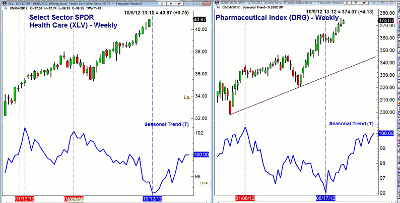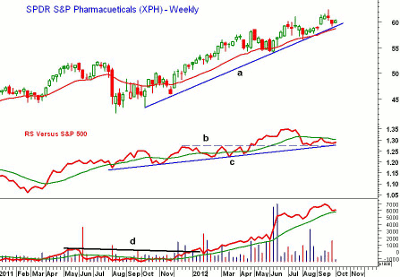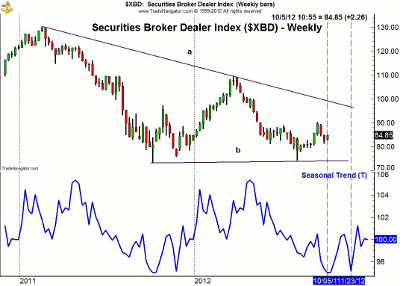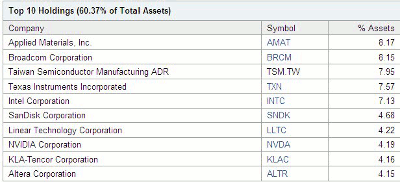The seasonal analysis indicates that five sectors or industry groups typically bottom in October, and the stocks in these sectors are good candidates to be market leaders going into the end of the year, writes MoneyShow’s Tom Aspray.
Over the past 20 years, October has been a pretty good month for stocks, with an average gain of 1.8%. According to Bespoke Investments, during this time period it is ranked third.
However, if you instead look at the past 40 years, October has averaged only a 0.58% gain. October still has a bad reputation due to the 1929 crash and the 22.56% drop in October 1987. The worst stretch during the 2008-2009 bear market also came in October.
The current environment does not look ready for an October crash...unless war breaks out in the Middle East, which could be enough to trigger a crash-like wave of selling.
There are several key sectors and industry groups that have a tendency to bottom in October, and most continue to move higher into the following year. As I have mentioned in previous articles, one needs to combine the long-term seasonal patterns with the technical signs to determine that the sector has become a market leader.
The seasonal low in gold coincided nicely with the technical readings, and the rally in gold caught many flat-footed, as they started to buy only after gold had already risen 10%. When the seasonal and technical signals agree, stocks in the sector can really take off. Let’s look at the best bets for October.
The technology sector, led by Apple (AAPL), has had a good past few months. The Select Sector SPDR Technology (XLK) was up 7.6% in the third quarter, which was more than 1% better than the Spyder Trust (SPY).
The seasonal chart shows that XLK typically bottoms on October 5 and rallies until early in the following year. It typically forms a secondary high in late April, but in 2012 it peaked early.
The semiconductor group is one segment of the technology sector that that also bottoms in October. The chart of the Philadelphia Semiconductor Index ($SOXX) shows that since 1995, it also typically formed an initial bottom on October 5, with a secondary low at the end of October.
The $SOXX typically tops on April 27, then declines until October. The chart also shows a minor rally in the early part of August, which did occur this year (see circle).
NEXT: A Closer Look at the Bottom in Technology
|pagebreak|The weekly chart of the Select Sector SPDR Technology (XLK) shows that it formed complex bottoms in both the summer of 2010 and 2011 that led to quite impressive rallies. XLK rallied 35.4% from low to high in 2010, and 36% from the October 2011 low to the March 2012 high.
From the low in June 2012 to the September high of $31.72, XLK was up 17.4%. A 35% rally from the June lows would take XLK up to $36.50.
The current chart shows that the recent pullback is holding above the high from March (line a). There is further support now at $28.50 to $30.
The correction into June fell right in the middle of the 38.2% to 50% Fibonacci support zone, which set up a low-risk buying opportunity last June. The weekly relative performance or RS analysis did confirm the March highs, which was a positive sign, as it did not start a new downtrend going into the June lows.
The RS line did confirm the recent highs before dropping below its WMA. A move in the RS line above its WMA is likely to signal that the correction is over.
The weekly on-balance volume (OBV) moved back above its WMA soon after the June lows, and has since made a series of higher highs and higher lows. It is now again trying to turn up from its WMA. A strong move through the downtrend would be a positive sign. The daily OBV (not shown) is still below its WMA, with next support at the July highs.
Moving onto the chip ETFs, iShares PHLX SOX Semiconductor Sector (SOXX) is not as liquid as the Market Vectors Semiconductor ETF (SMH), but is more broadly based, as SMH has an 18% weighting in Intel (INTC), as opposed to just 7% in SOXX. Of course, INTC is one of the weakest semiconductor stocks, which explains why SMH looks weaker technically than SOXX.
The largest three holdings in SOXX are Applied Materials (AMAT), Broadcom (BRCM), and Taiwan Semiconductor Manufacturing (TSM), which each makes up about 8%.
The weekly chart of SOXX shows a broad trading range (lines a and b) that goes back to 2010. The recent pullback has taken SOXX back to the support in the $50 area. There is more important support now in the $47.50 to $48 area (line b).
The weekly relative performance analysis has been in a strong downtrend (line c) since the 2011 high. The rally in July and August took the RS line above its WMA, but the formation was not consistent with a major low. This was one of the reasons why in early August, I recommended taking some profits in previously recommended semiconductor stocks.
The RS line has dropped back below its WMA, and is now approaching the previous lows. The RS line needs to move back above its WMA and the resistance (line d) to confirm that it has bottomed.
The weekly OBV does suggest that this sector is being accumulated, as it moved through resistance (line e) in July. This completed the bottom formation (lines e and f), and the OBV has just pulled back to its WMA.
The daily OBV (not shown) is below its WMA, though so far the volume on the decline has not been heavy. Given the current technical readings, SOXX may not bottom until later in the month, but I will be keeping an eye on some of the key semiconductor stocks for signs that they have completed their corrections.
NEXT: Another Sector to Watch in October
|pagebreak|The Select Sector SPDR Health Care (XLV) has been one of the most consistent sectors in 2012, as it is up 18.7% so far this year. Even more impressive is the 16.3% gain from the June lows.
Typically, this sector bottoms on October 10 (as indicated on the chart) and then peaks in January. A secondary high usually forms in early May, but not this year, as XLV has clearly bucked the seasonal trend.
One of the top health-care areas have been drug stocks, and the Pharmaceutical Index (DRG) is up close to 18% from the June lows. The seasonal chart shows that DRG typically bottoms on August 17, then peaks in early January. The index has just surpassed the 2007 highs, and is leading the major averages on the upside.
The weekly chart of the Select Sector SPDR Health Care (XLV) shows that the upper trend line resistance from the 2010 highs (line a) has just been decisively overcome. The monthly Starc+ band for October is at $42.25, with measured upside targets in the $43 to $44 area.
The technical studies last May suggested that the correction in XLV was likely over, as the relative performance broke through its downtrend (line c) and XLV was approaching the good support in the $36 area (line 1).
The RS line just tested its uptrend (line d) in mid-September, and has once again turned higher and made new highs.
The weekly OBV held firm during the April-May correction, which was a sign of strength. It dropped back to its WMA at the June lows before starting a new uptrend. It has made new highs with prices, and is holding above its uptrend (line e) and its WMA.
The SPDR S&P Pharmaceuticals (XPH) is a moderately liquid ETF that has a wide range of small and large drug companies. It peaked at $62.43 two weeks ago, and has since pulled back to initial support in the $59 to $60 area. Since the August 2011 lows, it is up over 43%, and since last November has respected its 20-week EMA quite well. There is good chart support now in the $56 to $58 area.
The relative performance broke through its resistance (line b) in April, as the major averages were topping out. The RS line peaked in June, then dropped back below its WMA in July. It is still holding above the more important support (line c).
The OBV moved through its seven-month resistance (line d) early in 2012, and has continued to make new highs with prices. Volume in June was very heavy, which caused a surge in OBV. The daily OBV (not shown) is also positive, as it is above its WMA
NEXT: One More Crucial Sector to Watch for a Bottom
|pagebreak|The last industry group that I think you should watch this month is the Securities Broker Dealer Index ($XBD). This group of stocks is often an important barometer of the market’s health, but unfortunately there is no liquid ETF that tracks it.
The weekly chart below shows that XBD tested the October 2011 lows in August (line b) and may be forming a double bottom. After a three-week rally from the August lows, it has now pulled back, but is holding well above the lows.
This group has a seasonal tendency to bottom on October 5, but can often have a secondary low on November 23.
There is initial resistance at 90.28, which if overcome on a weekly closing basis would be a strong indication that a bottom was in place. The weekly downtrend (line a) is now at 100. A close above the February high at 109.66 is needed to complete the double-bottom formation.
So what is the best way to implement this seasonal information into your analysis and investing? I would first assemble a list of stocks in each of the industry groups or sectors I have discussed. This can be done rather easily through a number of Web sites if you are not familiar with the industry group.
One easy way to start would be to look at the largest holdings of some of the ETFs I have discussed. The table below is from Yahoo.com and shows the top ten holdings of the iShares PHLX SOX Semiconductor Sector (SOXX). I would recommend that additional semiconductor stocks be added to this list, which can then be monitored via an online portfolio.
These stocks should be monitored on a weekly, if not daily basis. In particular, I would watch the volume. As was the case for housing stocks last October, a large increase in volume provided a strong indication that the homebuilders were starting to become market leaders.
Of course, the sector or industry group should also be closely watched. As I discussed recently, looking at the relative performance over multiple time frames can often give you an early indication that a sector or stock is becoming a market leader.



















